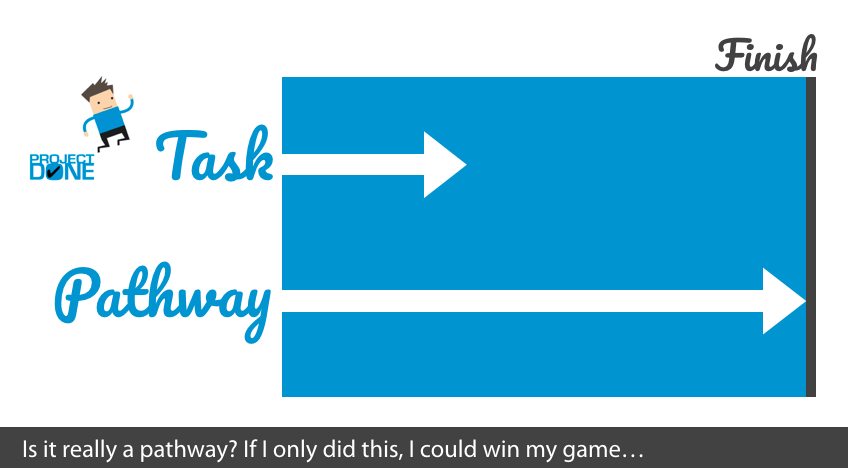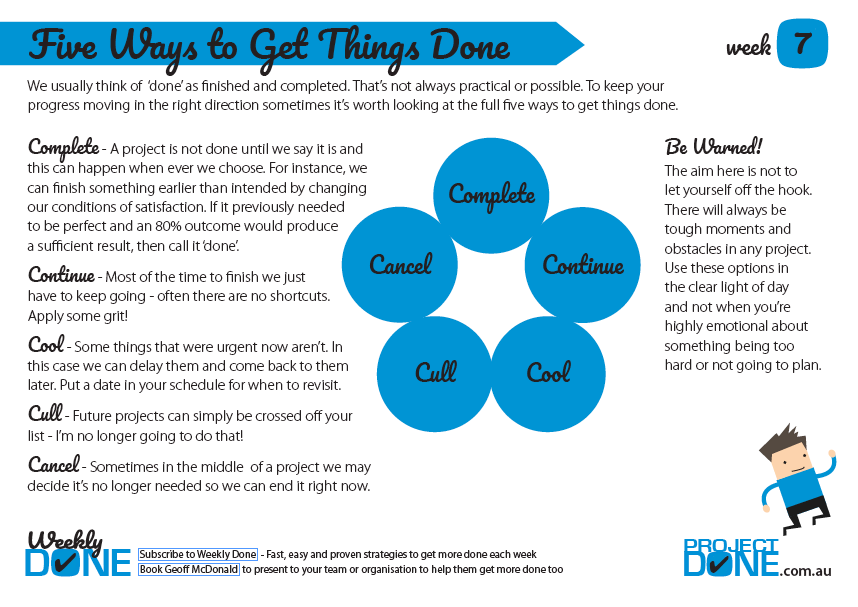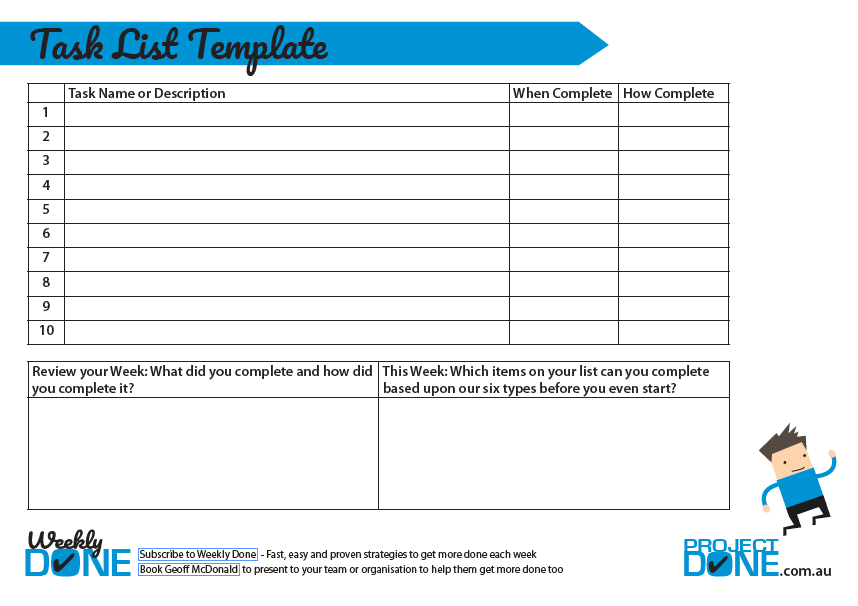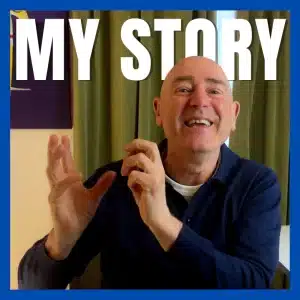
Project Tasks and Planning
All task lists need to start with a project. One of the key reasons that I started Project Done and wrote my books Done and Weekly Done was to help other people get more done. What I often found when talking to people was that they had a big long task list that was not connected directly to a project structure or even a long-term goal.
This often meant that people were busy working hard getting things done but were not heading in the direction they wanted in the most direct way.
Further, the lack of structure from not having a clear project design meant their actions were often haphazard and not focused. Again, this is not an effective way to spend your time (or your life).
As a result, the first step in defining your task list is to create an overarching project and plan accordingly.
In this – the ultimate guide to creating and completing your Task List today – we share the two keys to creating your task list, five ways to complete it plus a Task List template you can use to manage your actions and improve your performance.
How to Plan a Project
Here are the key questions to ask yourself in planning your project:
- Where do you want to be in 5-10 years?
- What do you need to fulfil that goal? These might be skills, experience, knowledge or contacts.
- What are the obvious steps along the way? For instance, if I want to speak at the TED conference, speaking at a TEDx event might be a useful prior milestone. This would require having something to talk about (an idea worth sharing) plus some skills around presenting your idea clearly and powerfully.
- Based on this timeline toward your long-term goal, what would be a great result in the next 90 days? This becomes your project result.
(I generally recommend you work in 90-day blocks because there are four such blocks each year and it’s a short enough time to stay focused and a long enough time to get a lot done. Brian Moran even has a book called the 12 Week Year – Get more done in 12 weeks than others do in 12 months – worth a read)
How to Define Your Task List
Now that you have your project goal over the next 90 days start to consider what actions you might take to achieve this goal.

In Project Done we talk about the two levels of this:
1 Strategy
A strategy is a pathway from where you are now to your end goal. Ask yourself: How will I get to my goal? You might like to pretend you are standing at the finish line having achieved your goal and look back at how you got there.
For example, imagine standing on top of the mountain you just climbed and looking down at the route you took and the obstacles you overcame.
Here are four strategy examples if I wanted to write a book:
- Write it all by myself
- Commission a ghostwriter to write all of it for me.
- Find a partner to co-author the book with me
- Find a coach to guide me in writing my book
2 Tasks
Now, based on the strategy you have chosen, write down the individual tasks you might take along the way. I suggest you write down lots of possible actions, then review your list and commit only to the ones that you think will produce the best results.
For example:
- Schedule writing time
- Find a book coach
- Find articles as part of my research
Bonus tip: A committed action is nice, making it a scheduled action with time allocated to it in your calendar is better gives you a much greater chance of making it happen.
The Best Way to Limit Your Task List
Before we look at the ways to finish your task list, it’s worth noting that there is a powerful way to limit your task list before you even begin: just say ‘no’.
If an item doesn’t make it onto your task list then, you don’t have to finish it. Easy peasy.
There’s an old saying that suggests ‘it might only take seconds to say ‘yes’ but it might take hours or even days to regret not saying ‘no’.
A useful tip here is not to commit automatically to anything. Yes, that’s right – to anything. Instead, give yourself a small break to consider the request. This might be as simple as counting down in your head for ten seconds to consider what’s involved. For bigger commitments, it might be to say ‘Let me get back to you within an hour’. Be specific when you will reply and make sure you follow up when you said you would – don’t adopt this as an avoidance strategy.
Let me be clear here: I’m not saying that you want to avoid saying ‘yes’ to important tasks. What I am saying is: be really clear as to what is important and what is not. Do your best to say ‘no’ to the unimportant things and you’ll instantly have fewer items on your task list to complete.

Five Ways to Finish Your Task List
We usually think of ‘done’ as finished and completed – literally, we cross the finish line. Sometimes in some projects that’s not always practical or possible. To keep your progress moving in the right direction it’s worth looking at the full five ways to get things done.
1 Complete the Task
A project is not done until we say it is and this can happen whenever we choose. For instance, we can finish something earlier than intended by changing our conditions of satisfaction. If it previously needed to be perfect and an 80% outcome would produce a sufficient result, then call it ‘done’.
For example, if you were creating slides for a presentation, do they really have to be perfect?
2 Continue the Task
Most of the time to finish we just have to keep going – often there are no shortcuts. Apply some grit!
2 Cool the Task
Some things that were urgent now aren’t. In this case we can delay them and come back to them later. Put a date in your schedule for when to revisit them.
For instance, if I was preparing a set of slides for a presentation on Friday and that presentation was delayed or cancelled, clearly I then shift the urgency from this task to another time (or not at all).
4 Cull the Task
Future projects can simply be crossed off your list – I’m no longer going to do that!
For instance, I had grand ambitions when I was much younger to complete an Ironman Triathlon. That’s a 3.8 kilometre swim (2.4 mile), 180 km cycle (112 mile) and a 42 km run (26 mile). One day I decided that I simply was no longer wanted to pu in the enormous amount of training this would require. In an instant, I simply crossed this item off my bucket list. Done. Dusted. Never to be considered again.
5 Cancel the Task
Sometimes in the middle of a project we may decide it’s no longer needed so we can end it right now.
For instance, when I was writing my book Done, I thought I had to write chapters on time and energy management. And, as I wrote the book, I decided these were not necessary so I crossed them off my list of things to do.
Bonus: Delegate the Task
A sixth way to complete your task list is to delegate the task. Simply put, find someone else to do it for you. This might be a colleague, friend, team members, boss, employee or contractor.
The important thing to note is that even if you do delegate the task, it’s not something you can necessarily tick off your list and forget about. You may still be responsible for it and you may need to manage the person doing it to ensure it is completed on time and as expected. Remember it is delegation not abdication.
Task List Template
To train yourself in managing your task list in the most effective way, use the following Task List Template to map out how you manage your tasks for an entire week.
Here are the steps:
- Write down the name/task description.
- Note down when a task was completed.
- Write down how you completed from our six types.
- At the end of your week, review your pattern. How many tasks did you complete? And what were your most common ways to do this?
- For the tasks that are not complete at the end of your week, take a few minutes to see if there is a way to complete them based on the six types before you even begin working on them.

Be Warned: Complete Your Task List
The aim here is not to let you off the hook for getting things done. There will always be tough moments and obstacles in any project. Use these options in the clear light of day and not when you’re highly emotional about something being too hard or not going to plan. Remember, the winner is not the person who completes the most tasks; it’s who completes the most important ones.



